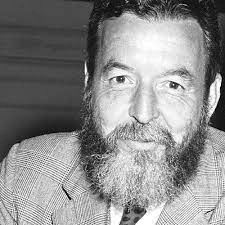A régi és az új mesterek

The Old And The New Masters
About suffering, about adoration, the old masters
Disagree. When someone suffers, no one else eats
Or walks or opens the window–no one breathes
As the sufferers watch the sufferer.
In St. Sebastian Mourned by St. Irene
The flame of one torch is the only light.
All the eyes except the maidservant’s (she weeps
And covers them with a cloth) are fixed on the shaft
Set in his chest like a column; St. Irene’s
Hands are spread in the gesture of the Madonna,
Revealing, accepting, what she does not understand.
Her hands say: “Lo! Behold!”
Beside her a monk’s hooded head is bowed, his hands
Are put together in the work of mourning.
It is as if they were still looking at the lance
Piercing the side of Christ, nailed on his cross.
The same nails pierce all their hands and feet, the same
Thin blood, mixed with water, trickles from their sides.
The taste of vinegar is on every tongue
That gasps, “My God, my God, why hast Thou forsaken me?”
They watch, they are, the one thing in the world.
So, earlier, everything is pointed
In van der Goes’ Nativity, toward the naked
Shining baby, like the needle of a compass.
The different orders and sizes of the world:
The angels like Little People, perched in the rafters
Or hovering in mid-air like hummingbirds;
The shepherds, so big and crude, so plainly adoring;
The medium-sized donor, his little family,
And their big patron saints; the Virgin who kneels
Before her child in worship; the Magi out in the hills
With their camels–they ask directions, and have pointed out
By a man kneeling, the true way; the ox
And the donkey, two heads in the manger
So much greater than a human head, who also adore;
Even the offerings, a sheaf of wheat,
A jar and a glass of flowers, are absolutely still
In natural concentration, as they take their part
In the salvation of the natural world.
The time of the world concentrates
On this one inst ant: far off in the rocks
You can see Mary and Joseph and their donkey
Coming to Bethlehem; on the grassy hillside
Where their flocks are grazing, the shepherds gesticulate
In wonder at the star; and so many hundreds
Of years in the future, the donor, his wife,
And their children are kneeling, looking: everything
That was or will be in the world is fixed
On its small, helpless, human center.
After a while the masters show the crucifixion
In one corner of the canvas: the men come to see
What is important, see that it is not important.
The new masters paint a subject as they please,
And Veronese is prosecuted by the Inquisition
For the dogs playing at the feet of Christ,
The earth is a planet among galaxies.
Later Christ disappears, the dogs disappear: in abstract
Understanding, without adoration, the last master puts
Colors on canvas, a picture of the universe
In which a bright spot somewhere in the corner
Is the small radioac tive planet men called Earth.
A régi és az új mesterek
Szenvedést, imádást illetően a régi
Mesterek véleménye más. Ha valaki szenved,
A többi nem eszik, nem moccan, nem nyit ablakot -
Lélegzetvisszafojtva nézi a szenvedőt.
A Szent Irén gyászolja Szent Sebestyént című képen
Egyetlen fáklya lobog csak. A szemek,
Kivéve egy szolgálóét (sír, s az arcát
Kendővel takarja el), mind-mind a dárdanyélre
Szegeződnek: mellkasba tört oszlop: Szent Irén
Madonna-mozdulattal tárja szét
Karját, így fogadván be a felfoghatatlant.
Keze ekképp szól: „Lássátok! Íme!" -
Mellette kámzsás, görnyedt szerzetesfej,
Két kéz, eggyéfonódva a gyász gesztusában.
Mintha azt néznék most is, azt a lándzsát
A Keresztrefeszített oldalában.
S kezük-lábuk is azok a szögek
Járnák át, az a vízzel kevert vér csorogna rajtuk,
S ugyanaz az ecetíz nyelvükön,
Zihálva: „Istenem, Istenem, mért hagytál el engem?"
Néznek csak, s rajtuk kívül: nincs világ.
S még korábban : ekképp mutat van der Goes Jézus
Születése című képén minden a meztelen,
Fényes kisded felé, iránytű hegyeként.
A világ minden rangja-rendjei :
Angyalok, csöpp manókként gerendákon
Gubbasztva, vagy kolibri-körözéssel, a légben;
S a durva pásztorok is mily tisztán imádják;
A kistermetű donor meg a család, s a
Roppant védszentek; ott térdel a Szűz,
Imádva a gyermeket; s a Mágusok a hegyek közt
Jönnek, tevéstől - kérdezik az utat, s egy
Térdelő megmutatja; az ökör s a szamár
Kinéz a jászol mellől, nem emberszabású
Ormótlan fejük is merő imádat;
És az ajándékok : egy kéve búza,
Agyagkorsó, virágok, azok is mintha
Elmélyülten viselnék büszke részük,
Mi a világ megváltásából nekik jut.
S az Idő is egyetlen pillanatban
Összpontosul: amott messze a sziklák
Közt látjuk Máriát s Józsefet szamárral,
Jönnek Betlehembe; a füves dombon
Fehér nyáj legel, pásztorok hadonásznak:
Csodálják a csillagot; s aztán - évszázadokat
Ugorván a jövőbe - ott térdel a donor,
Feleségestől-gyerekestől, és néz; mindent,
Ami csak volt s lesz a világon, odavonz
A csöppnyi, árva, emberi középpont.
Későbbi mesterek vásznán a keresztrefeszités már
A kép sarkába szorult: mindenki a fontos
Dolgokra vágyott, s úgy látta, ez nem fontos.
Az új mesterek szabadabban választják meg a témát;
Veronesét, ekképpen, üldözte az Inkvizíció,
Mert Krisztus lábaihoz játszadozó kutyákat festett;
A Föld: csak egy bolygó a Tejutak közt.
Később eltűnik Krisztus, a kutyák - absztrakt
Egyetértésben, imádás nélkül, az újabb mestereknél
Színek vannak a vásznon, a Világegyetem képe,
S egy fénylő pont valahol a sarokban:
Kis rádióaktiv bolygó, a neve: Föld.
Fordította: Tandori Dezső
Forrás: www.magyarulbabelben.net